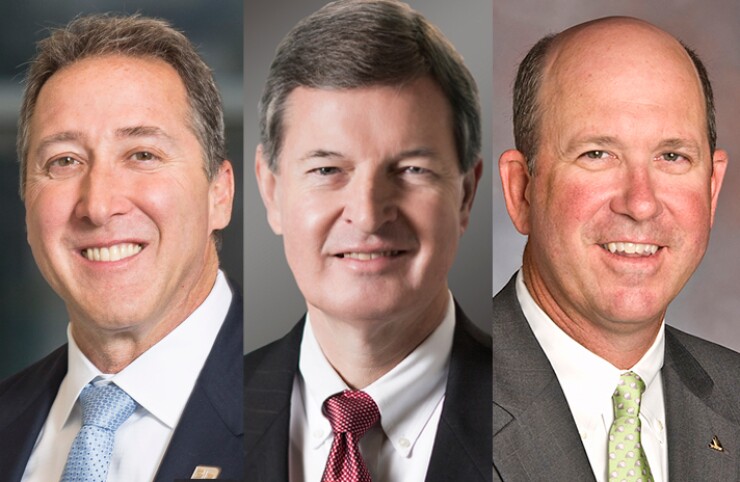The Federal Reserve’s recent decision to cut interest rates by a quarter of a percentage point hasn’t stimulated loan demand in the way bankers hoped it might and could even be discouraging some businesses from borrowing, Regions Financial CEO John Turner said Tuesday.
Speaking at an investor conference in New York Tuesday, Turner said that while Regions’ loan growth has been decent this quarter, he is seeing some reluctance among business owners to invest in expansion given the ongoing U.S.-China trade war and signals from the Fed that more rate cuts might be coming.

“If you're a business owner, you think the economy's good, but if the Fed's going to cut a rate, what message is that sending to business today?” said Turner, who is also president of the $128 billion-asset Regions, of Birmingham, Ala. “Does the Fed know something business doesn't know about the overall economy? I think that’s creating some pause.”
Greg Carmichael, the chairman and CEO of the $169 billion-asset Fifth Third Bancorp in Cincinnati, raised similar concerns in a presentation at the same conference hosted by Barclays.
He said he is “relatively optimistic” about the prospects for loan growth — commercial and industrial loans this quarter are up about 7% year over year — but acknowledged that business confidence is weakening a bit.
“We're seeing a little more cautious commercial client today … with respect to capital expenditures and so forth,” Carmichael said.
Recent data from the Federal Reserve showed
Most bankers hoped the Fed’s rate cut on July 31 would boost loan demand to offset an expected decline in net interest margins. With lower rates, banks’ net interest margins are likely to shrink, as floating-rate loans reset to lower yields and new loans and securities are booked at reduced yields.
Wells Fargo said Monday that it
Still, several bankers at the Barclays conference said there is more reason for optimism than pessimism. Kelly King, chairman and CEO of the $223 billion-asset BB&T in Winston-Salem, N.C., said he even expects the Fed to start raising rates again next year.
“Obviously we could talk ourselves into a recession if we don’t watch out,” King said. “But for today, at least in market that we serve … we have reason to be fairly optimistic going forward.”
Very little of the upheaval caused on trade wars has affected BB&T’s commercial clients, King said. He reiterated that BB&T expects annual loan growth of between 4% and 6% this year and he said he “would lean towards the high side of that.”
“When you read a lot about trade wars and all that’s going on there and all of the angst that’s related to that, that’s fundamentally … difficult for international businesses,” King said. “But our businesses on Main Street don’t get directly and immediately hit in terms of the inventories in the supply chain.”
King said he’s seen strong loan demand in all categories, including mortgages, commercial and industrial and indirect auto.
“It’s really across the board,” King said.
The $145 billion-asset KeyCorp in Cleveland has also seen solid demand from its commercial and industrial clients, Chief Financial Officer Don Kimble said during a presentation Monday.
“As far as loan growth, what we talked about for this year has been toward the high end of our targeted range for the full year,” Kimble said. “The drivers there really are C&I growth, which we continue to see strong pipelines and activity there.”
KeyCorp has forecast average loans between $90 billion and $91 billion for 2019, up from $88.3 billion at Dec. 31, 2018.
Other commercially focused banks have taken steps to ensure corporate loan demand remains healthy. The $71 billion-asset Comerica in Dallas raised deposit rates by 5 to 7 basis points this quarter to attract more commercial clients, even after the Fed cut rates, Muneera Carr, chief financial officer, said Tuesday at the conference.
Even without the lure of higher deposit rates, Comerica CEO Curtis Farmer said the bank’s pipeline for new loans to midsize businesses “remains strong.” Some clients’ concerns about the economy and trade wars may be dampening capital expenditures, but it has not been enough yet to hurt loan demand.
“That may portend for us to see some decline in loan activity at some point,” Farmer said. “But, right now, borrowing remains relatively healthy.”





